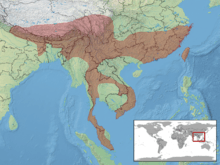Ovophis monticola
| Ovophis monticola | |
|---|---|
| Scientific classification | |
| Kingdom: | Animalia |
| Phylum: | Chordata |
| Subphylum: | Vertebrata |
| Class: | Reptilia |
| Order: | Squamata |
| Suborder: | Serpentes |
| Family: | Viperidae |
| Subfamily: | Crotalinae |
| Genus: | Ovophis |
| Species: | O. monticola |
| Binomial name | |
| Ovophis monticola (Günther, 1864) | |
 | |
| Synonyms | |
| |
Ovophis monticola is a venomous pitviper species found in Asia. Currently, five subspecies are recognized, including the nominate subspecies described here.[5] Recent taxonomic work suggests that most of these should be considered as separate species.[6] IUCN has already evaluated O. m. makazayazaya as Ovophis makazayazaya.[7]
Description
Total length of males 49 cm (19¼ inches), of females 110 cm (43¼ inches); tail length of males 8 cm (3⅛ inches), of females 15 cm (5⅞ inches).[8]
The head has a short snout, a little more than twice the length of the diameter of the eye. The crown is covered by small scales rather than large shields, while the scales are usually smooth, feebly imbricate. The first upper labial is not fused to the nasal and is completely separated by a suture. The supraoculars are large, 5-9 scales in a line between them. The internasals are usually not in contact with one another, separated by 2 small suprapostrostral scales. There are 7-10 upper labials, the second of which is usually fused to the scale bordering the facial sensory pit anteriorly. The fourth and fifth upper labials are beneath the eye, but separated from orbit by a series of 2-4 small scales.[8]
The body is stout. The dorsal scales are smooth or weakly keeled, in 23-25, occasionally in 19 or 21 longitudinal rows at midbody. Ventral scales and subcaudals (Myanmar, northeastern India and adjacent areas of China and Thailand) 137-176 and 36-62 respectively, subcaudals mixed paired and single, occasionally all unpaired (ventrals and subcaudals for southern China, Vietnam, Laos: 127-144 and 36-54, and Malaysian Peninsula: 133-137 and 22-28 respectively [fide Smith 1943:509]).[8]
Common names
Mountain pitviper,[3] mountain viper, Chinese pit viper, spotted pit viper, Arisan habu,[4] mountain pit viper, Chinese mountain pit viper.[9] Bengali name: পাহাড়ী বোড়া সাপ (Pahari boda sap).
Geographic range
Found in Asia in Nepal, India (Assam, Sikkim, Mizoram,Nagaland), Bangladesh[10] (already stated on the subspecies table), Myanmar, Tibet, China (Zhejiang, Fujian, Sichuan, Yunnan, Tibet), Cambodia, Thailand, Laos, Vietnam, West Malaysia, Singapore and Indonesia (Sumatra). The type locality is described as "Sikkim" (India).[2]
Subspecies
| Subspecies[5] | Taxon author[5] | Common name[3] | Geographic range[3] |
|---|---|---|---|
| O. m. convictus | (Stoliczka, 1870) | Indo-Malayan mountain pitviper | Indonesia (Sumatra), West Malaysia, Singapore, Thailand and Vietnam as far north as the central Annam Mountains. |
| O. m. makazayazaya | (Takahashi, 1922) | Taiwan mountain pitviper | Taiwan: Chuchuku, Arishan, Makazayazaya and Taipei. |
| O. m. monticola | (Günther, 1864) | Mountain pitviper | Bangladesh (Chittagong Hill Tracts), China (Sichuan, Tibet Autonomous Region, Yunnan, India (Arunachal Pradesh, Assam, Mizoram, Manipur, Meghalaya, Nagaland, Sikkim, Uttarakhand and West Bengal), Myanmar (Chin, Kachin and Shan) and Nepal. |
| O. m. zayuensis | (Jiang, 1977) | Zayuan mountain pitviper | China, Tibet Autonomous Region: in Zayü and Mêdog counties at 1,800-2,200 m (5,900-7,200 feet) elevation. |
| O. m. zhaokentangi | Zhao, 1995 | Gaoligong mountain pitviper | Goaligong Shan, north of Pianma, Lushui County, Yunnan Province, China. |
Venom
Little is known about the venom of this specie but it is presumed to contain haemorrhagins and procoagulants. There has been one recorded fatality from the bite of this specie.[11]
See also
- List of crotaline species and subspecies
- Crotalinae by common name
- Crotalinae by taxonomic synonyms
- Snakebite
References
- ↑ Malhotra, A. (2010). "Ovophis monticola". IUCN Red List of Threatened Species. Version 2012.1. International Union for Conservation of Nature. Retrieved 21 October 2012.
- 1 2 McDiarmid RW, Campbell JA, Touré T. 1999. Snake Species of the World: A Taxonomic and Geographic Reference, vol. 1. Herpetologists' League. 511 pp. ISBN 1-893777-00-6 (series). ISBN 1-893777-01-4 (volume).
- 1 2 3 4 Gumprecht A, Tillack F, Orlov NL, Captain A, Ryabov S. 2004. Asian Pitvipers. GeitjeBooks Berlin. 1st Edition. 368 pp. ISBN 3-937975-00-4.
- 1 2 U.S. Navy. 1991. Poisonous Snakes of the World. US Govt. New York: Dover Publications Inc. 203 pp. ISBN 0-486-26629-X.
- 1 2 3 "Ovophis monticola". Integrated Taxonomic Information System. Retrieved 24 August 2007.
- ↑ Malhotra, A.; Dawson, K.; Guo, P.; Thorpe, R. S. (2011). "Phylogenetic structure and species boundaries in the mountain pitviper Ovophis monticola (Serpentes: Viperidae: Crotalinae) in Asia". Molecular Phylogenetics and Evolution. 59 (2): 444–457. doi:10.1016/j.ympev.2011.02.010. PMID 21315823.
- ↑ Lau, M.; Zhou, Z. & Guo, P. (2012). "Ovophis makazayazaya". IUCN Red List of Threatened Species. Version 2012.1. International Union for Conservation of Nature. Retrieved 21 October 2012.
- 1 2 3 Leviton AE, Wogan GOU, Koo MS, Zug GR, Lucas RS, Vindum JV. 2003. The Dangerously Venomous Snakes of Myanmar, Illustrated Checklist with Keys. Proc. Cal. Acad. Sci. 54 (24):407-462. PDF at Smithsonian National Museum of Natural History, Division of Amphibians and Reptiles. Accessed 8 August 2006.
- ↑ Brown JH. 1973. Toxicology and Pharmacology of Venoms from Poisonous Snakes. Springfield, Illinois: Charles C. Thomas. 184 pp. LCCCN 73-229. ISBN 0-398-02808-7.
- ↑ http://reptile-database.reptarium.cz/species?genus=Ovophis&species=monticola
- ↑ Venomous Snakes of the World by Mark O'Shea, Page number 104
Further reading
- Günther, A. 1864. The Reptiles of British India. The Ray Society. London. (Taylor & Francis, Printers.) xxvii + 452 pp. (Trimeresurus monticola, p. 388 + Plate XXIV., fig. B.)
- Tillack, F.; Shah, K.B.; Gumprecht, A. & Husain, A. 2003 Anmerkungen zur Verbreitung, Morphologie, Biologie, Haltung und Nachzucht der Berg-Grubenotter Ovophis monticola monticola (Günther, 1864) (Serpentes, Viperidae, Crotalinae). Sauria 25 (4): 29-46
External links
- Ovophis monticola at the Reptarium.cz Reptile Database. Accessed 12 December 2007.
